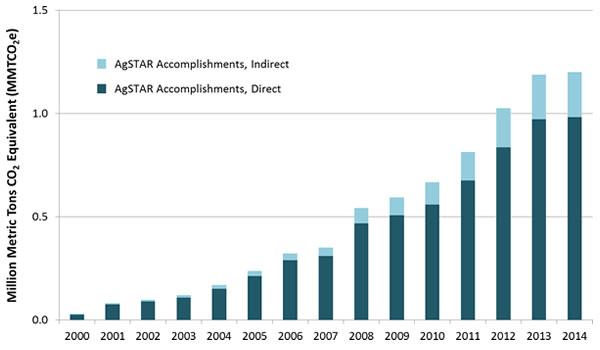AgSTAR Accomplishments
Since its inception in 1994, AgSTAR has made meaningful progress reducing greenhouse gas (GHG) emissions in the agriculture sector. Through outreach, education, training and other tools, AgSTAR continues to support anaerobic digestion of livestock waste.
Anaerobic digestion of livestock waste reduces GHG emissions in two ways:
- Methane emissions are directly reduced as biogas is captured and used as a renewable fuel.
- The energy generated displaces the use of fossil fuels, further avoiding the emission of GHGs and other pollutants.
Recent AgSTAR Accomplishments
“AgSTAR is a tremendous resource to the Nebraska Methane Workgroup. The program serves as a valuable conduit of information to connect states facing similar issues, and this has been particularly helpful.”
- Approximately 247 anaerobic digesters are operating at commercial livestock farms in the United States. To find out more about projects that are under construction, operating or shut down, explore:
- In 2014, AgSTAR helped reduce GHG emissions by 1.20 million metric tons of CO2 equivalent (MMTCO2e)
- 0.98 MMTCO2e direct emission reductions
- 0.22 MMTCO2e emissions avoided
2014 AgSTAR GHG Emission Reductions
 1.20 MMTCO2e reductions are equivalent to the energy used by 109,489 homes in one year
1.20 MMTCO2e reductions are equivalent to the energy used by 109,489 homes in one yearEPA’s Greenhouse Gas Equivalencies Calculator provides other GHG equivalencies.
Greenhouse Gas Reductions Due to AgSTAR Programs
 Column chart illustrating AgSTAR's accomplishments in directly and indirectly reducing greenhouse gas emissions from 2000 through 2014. The chart shows a gradual increase each year with direct GHG reductions of 0.98 MMTCO2e in 2014 and indirect GHG reductions of 0.22 MMTCO2e in 2014.
Column chart illustrating AgSTAR's accomplishments in directly and indirectly reducing greenhouse gas emissions from 2000 through 2014. The chart shows a gradual increase each year with direct GHG reductions of 0.98 MMTCO2e in 2014 and indirect GHG reductions of 0.22 MMTCO2e in 2014.
In addition to these environmental benefits, AgSTAR has:
- Organized education and outreach events, including a national conference
- Developed technical resources for farmers, vendors and other stakeholders
- Launched the AgSTAR Partners Program which includes state and non-governmental stakeholders
